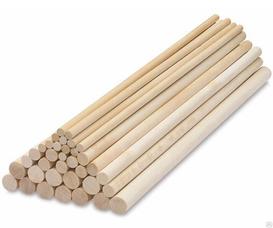Dowels or nails: advantages and disadvantages of fasteners for timber

During the construction of log houses, the elements of the log house are fixed to each other using wooden dowels or metal nails. The task of the fasteners is to strengthen the entire structure, as well as to preserve its integrity in the process of intensive shrinkage and housing operation. Including, be it pins or nails, they should not interfere with the natural sealing of the joints between the crowns, which occurs under the dead weight of the timber.
Pros and cons of wooden dowels
Wooden pins are a classic fastener for assembling a log house from a bar, which is a stick made of hardwood. Most often, birch is used for manufacturing. The length of standard wooden dowels is 250 mm. Diameter from 22 mm to 25 mm. To fix the timber under the pins, holes of the corresponding section are drilled so that the fasteners pass through no more than two adjacent crowns. The pins are installed with a wooden or rubber hammer.
Pluses of dowels:
- High bond strength.
- Do not interfere with the natural shrinkage of the timber.
- Lack of corrosion and rust in the frame.
- When finishing work, walls with dowels inside can be drilled without fear, self-tapping screws can be screwed into them, grooves and shafts can be made.
- The durability of the fasteners is practically the same as that of the timber.
However, wooden pins are not always used in the construction of log houses. This is due to some of the disadvantages of this type of fastener. The first is the relatively high cost. The second is the low speed of installation.
On average, if we compare a dowel and a nail, then drilling and driving the first one takes two minutes more than the second. Accordingly, if about 400-500 pieces of such fasteners are used in a typical log house, construction using dowels takes about two working days more than using metal nails.
Pros and cons of metal nails
Nails for assembling a log house from a bar are familiar standard fasteners with a length of 200 mm. If they are of high quality, then they have a zinc coating situs slot gampang menang that protects the metal from moisture contained in the wood and, accordingly, from corrosion and rusting. There is no need to drill holes for nails, unlike dowels. They are simply hammered into the upper and the following beam from below with a hammer.
Pros of nails:
- Relatively low cost.
- There is no need to drill holes for each fastener.
- Installation takes less time and effort.
- Corrosion-resistant when provided with a protective coating.
- Do not interfere with the shrinkage of the timber with proper use.
Regarding the last point, there is an opinion that the nails will prevent the upper rims from dropping during the shrinkage process, which provokes the formation of gaps between the rows. Practice shows that this is a myth, most likely invented by those who are strenuously trying to sell their wooden dowels. To date, thousands of log houses on 200 mm metal nails have already been built and passed all sorts of stages of shrinkage. No gaps “due to the fault” of the fasteners between the crowns are not formed. The cracks are the fault of unscrupulous timber manufacturers and builders far from modern technologies.
If we talk about the more significant and real disadvantages of metal nails for a bar, then, of course, there are also nuances here. Firstly, the strength of the nail joint is an order of magnitude lower than when using pins. However, this refers to tensile strength and not lateral shear. And since no effort is applied from below to the log beam either during operation or during shrinkage, this disadvantage can be neglected.
Secondly, when using nails, the walls of a wooden house will be literally “stuffed” with metal. For the wood itself, this is not so important. But when finishing work, you will have to take some care. In order not to bump into nails in the walls when drilling, screwing in self-tapping screws and grooving, it is enough to know where this very metal is. And since the fastening of the timber is performed not in a chaotic manner, but according to a certain principle, this task is quite simple.
Outcome
For the construction of a log house, you can use both wooden pins and metal nails. The tangible difference between these fasteners lies only in the price and installation speed. Otherwise, the shortcomings of both the first and the second are, by and large, just unconfirmed myths.